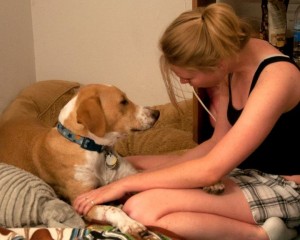Michael Baugh CPDT-KA, CDBC
I love a good story of redemption. That’s probably why I’m drawn to dogs we commonly call fearful or aggressive. They’re the barkers and growlers and lungers and biters. They walk a hard path and are often misunderstood. They are the hard cases with no guarantees for anyone involved. Few have walked a path more difficult than Tad, my newest client. A young woman named Tiffany found him along the side of a country road in Montgomery, Texas late last March. Tad was eaten away by mange and malnourishment, weak and wounded. The veterinarian at the clinic where Tiffany works wondered if Tad would survive the night. He did. As he grew stronger, though, his behavior grew worse. Tad started barking and growling at visitors to the clinic. Then he bit Tiffany’s father who had the double misfortune of falling and frightening Tad in the process. That would have been the end of the line for some dogs. But not Tad.
It turns out Tiffany is a storyteller, and a good one at that. She began blogging about her Abandoned Dog the day she found him. She posted pictures and videos of Tad, and before too long he had a worldwide following (nearly 5,000 fans on Facebook as of this writing). When Tad needed money for expensive veterinary care, hundreds of people responded. And when word came that he needed a trainer, more help rolled in. It only took a phone call for one of his followers to find me.
 I liked Tad the minute I saw him. He’s smaller than he looks in pictures and video (about 55 lbs). He’s also loose and wiggly most of the time, a young dog coming into his prime. We met outside of The Fundamental Dog near The Woodlands. I like to meet dogs like Tad on neutral territory, outdoors if possible. The idea is to make it easy for the dog to make the best choice possible. If Tad didn’t like me, he had plenty of room to move away, an easier choice than barking or lunging. This wasn’t his place, so there was no pressure on him to make me go away if I looked like bad news. Fortunately, he trotted right up to me. He seemed pleasantly surprised when I pulled out my “secret weapon:” Cheeze Whiz (Tad’s favorite). It wasn’t a bribe. If you come to my house, and I want us to be friends, I’ll offer you a snack. It’s good manners. Of course, there’s good behavior science behind it too.
I liked Tad the minute I saw him. He’s smaller than he looks in pictures and video (about 55 lbs). He’s also loose and wiggly most of the time, a young dog coming into his prime. We met outside of The Fundamental Dog near The Woodlands. I like to meet dogs like Tad on neutral territory, outdoors if possible. The idea is to make it easy for the dog to make the best choice possible. If Tad didn’t like me, he had plenty of room to move away, an easier choice than barking or lunging. This wasn’t his place, so there was no pressure on him to make me go away if I looked like bad news. Fortunately, he trotted right up to me. He seemed pleasantly surprised when I pulled out my “secret weapon:” Cheeze Whiz (Tad’s favorite). It wasn’t a bribe. If you come to my house, and I want us to be friends, I’ll offer you a snack. It’s good manners. Of course, there’s good behavior science behind it too.
I won’t take too much time talking about the science of dog training. Most people already know I depend exclusively on well tested and verified behavior science in my practice. Very little (if anything) of what I teach is based on folk wisdom or popular consensus. That’s my bias. If there isn’t a body of data to support a training protocol, then I’m not teaching it. More importantly, I don’t use any methods that frighten or hurt a dog. Tad’s been frightened and hurt enough. What he needs now is to learn that people are safe, and that good things happen for him when new people show up on the scene. I got to be one of the first to teach him that. Tad liked me and my colleague Marie. It made my day.
This is about as geeky as I’ll get. Tad is learning that every time he sees a new person (or even an unfamiliar person he’s seen before) tasty bits of food soon follow. Some of these people may actually choose to hand Tad the food themselves. This is called Classical Conditioning. Person predicts Yummy food. In addition, we’re pairing up the sound of the door chime at the veterinary clinic with lovely snacks as well, because the chime is also associated with new people coming in. Chime predicts Yummy food. Right now chimes and people are associated with increased heart rate, shallow respiration, dilated pupils, elevated cortisol (most likely), and piloerection (hackles up) – in other words, fear. In order to change the association, we’ll need to be careful to protect Tad from repeated full-on exposure to the scary stuff (new people). He’s going to meet his new friends much the same way he met me, in a controlled and calm setting. The rest of the time he’ll be away from the hustle bustle. Tad never has to be afraid again.
Was Tad abused? The physical evidence clearly points to that. The behavioral evidence, interestingly enough, is less clear. Many dogs display behavior similar to Tad’s without any history of abuse. Lack of experience with a wide variety of human beings can lead to what we call “socialization deficit.” Dogs who behave in ways related to fear and aggression often didn’t have enough positive exposure to human beings early in life (5-16 weeks of age). That lack of experience is enough to create serious problems down the line. We trainers see it a lot in puppy mill dogs, and even in some dogs who come from so-called reputable breeders. This is precisely why well-designed classes for young puppies are so important. A lot of street dogs, like Tad, have a very mixed bag of early socialization. Regardless, remedial socialization in canine adolescence and early adulthood can help turn things around. That’s what I’m hoping for with Tad.
Tad’s not all that unlike a lot of the dogs I see day-in-day out. Maybe that’s what makes him special. Being a dog is quite enough, thank you. He doesn’t have titles or ribbons, and his coat is still pocked with mange. He’s just a dog from a country road in rural Texas. But His story of survival against great odds touched us nonetheless, thousands of us. Tad is one dog who stands for so many other dogs, too many who are left to suffer and die young. Perhaps that’s what gave so many of us pause, and made us reflect on the better measures of being human. People failed Tad, but it was also people who lifted him up, thousands of people. There’s a story of redemption being told here – not just his, but our own.



